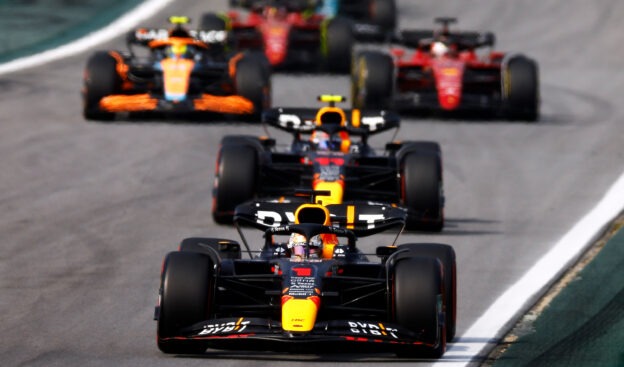Newey says F1 sustainability is heading in wrong direction

Dec.20 - Adrian Newey has questioned the narrative surrounding the future of Formula 1 and motoring in general.
Arguably the most famous designer in the sport's history admits that the environment and sustainability are "big issues" that should be paid attention to.
"Formula 1 can and must play a role in that," Newey, the chief technical officer at Red Bull, told motorsport-magazin.com.
"But there's all this discussion about where the energy source should come from – electric, biofuel, synthetic fuel, hydrogen. There's a lot of misinformation floating around on the subject, especially the electrical side.
"People are starting to realise that the carbon footprint of producing an electric vehicle is much larger than that of a petrol vehicle," the 63-year-old added.
"The assumption that electricity from wind or solar energy is emission-free is simply not correct."
Newey also says wind turbines require "an enormous amount of concrete" to construct, and that is "one of the biggest causes of C02 emissions".
"These structures also contain a lot of aluminium and copper, which are also very polluting in the production phase. So it's not zero emissions."
As for the Formula 1 cars, the hybrid 'power unit' technology is extraordinarily efficient but Newey says the hefty weight of the cars offsets a lot of that.
"No one seems to be talking about the amount of energy used to keep the car moving," he said.
And in the road car industry, Newey says it's "illogical" that manufacturers get credit for bigger and heavier cars as long as the exhaust is less polluting.
"It's run by the government, which is influenced by the car manufacturers, which is very similar to motorsport these days," he insisted.
"Some changes in Formula 1 are also the result of lobbying," Newey added. "I think we need smaller, lighter and more energy efficient cars.
"Our cars have become bigger and heavier and are not particularly aerodynamically efficient because they have a lot of drag. Unfortunately, Formula 1 has now achieved the exact opposite with these new rules.
"It is clear that for F1 and the general auto industry, bigger and heavier cars and people's obsession with whether they run on batteries or petrol is the exact wrong direction.
"The biggest problem is the amount of energy it takes to move the damn thing, no matter where that energy comes from," the Briton added.
"It seems that the technical rules of Formula 1 don't acknowledge that, because of course the big car manufacturers don't want that. At least that's what I think."
✅ Check out more posts with related topics:














Adrian Newey makes a lot of sense, if not commensurate with political agendas! Lighter vehicles needing less energy to move them is a far more efficient resolution. However, that doesn't satisfy the politicians who are driven by the minority making the loudest noise.
Has anyone else been to Denmark and seen the mass of wind turbines planted in the sea and over the land? When I was last there, a few years ago, I would estimate that about 40 percent of the wind turbines were inactive, even though there were substantial winds. It seems they had mechanical malfunctions.
Yep, wind turbines need a lot of service compared to solar panels.
Not very scientific. In 2019 47% of all power used in Demark cam from wind turbines. Probably 50% now.
FACT. I am NOT an engineer and I do recognize our climate challenges. Just seems to me that a 1200# race car with a 3 litre V8 screamer running on syn fuel would be pretty damned efficient and maybe we could have real F1 racing again. I know....I'm dreaming.
The simplest way to save the planet ( possibly the only way) would be to restrict the worlds birth rate, everything needed is already available.
Correct! Less population means less pollution. Reducing the birth rate will also solve the problems of increasing food production to feed the increasing numbers, and at the same time reducing the amounts of welfare we currently need to pay!
He's spot on.
It is hypocritical at best to brag about carbon footprints, or lack there of. F1 travels the world in search of governments willing to subsidize the sport [read "Middle Eastern petrol states."] Doing so, the cars they race that are built in England, or Italy, and the large crews that service and operate them are packed into jets, lifted over 20,000 feet in the air, flow over the race sites, and, dropped back to the surface. After the race, they are reloaded into jets, and sent home, or to the next race. This uses an immense about of kerosine, which is reduced to water and carbon dioxide when burned. The carbon footprint of F1 is huge. Spare me the crap about burning a few thousand liters less fuel during the actual race. If F1 really wanted to be more "green," how about using local crews, and, rejecting the subsidizes of petrol states?
Got it! Rubber. Donated by F1 for birth control toreduce...everything...and great big rubber bands to power aircraft and cars wound up by the huge teams, god i’m Brilliant.
Totally and absolutely agree, the cars need to be smaller, shorter and lighter.
If that means less onboard technology, then so be it.
We are talking about the long term future of f1 racing after all.
The calendar could also perhaps need a rethink, too much hoping around.
✅ Checkout the latest 50 F1 Fans comments.